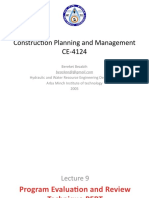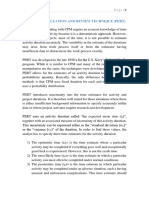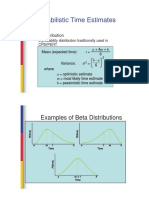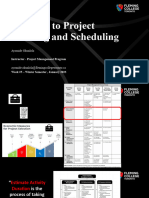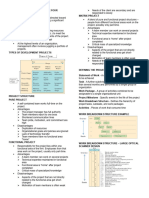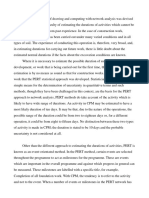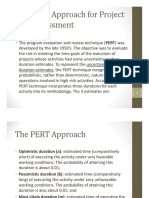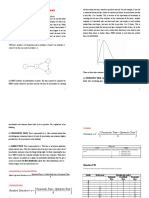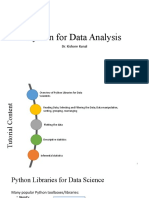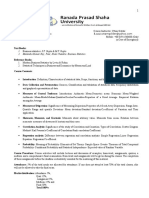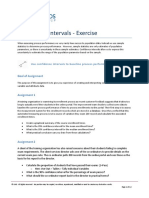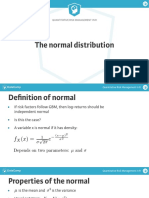12-11-2024
CE4004D - CONSTRUCTION MANAGEMENT AND
QUANTITY SURVEYING
Dr. Prabhu V., Ph. D.
Ad hoc faculty,
Department of Civil Engineering,
National Institute of Technology Calicut,
Calicut -673601, India
CE4004D CONSTRUCTION MANAGEMENT AND QUANTITY SURVEYING
PERT - Time estimates
• Two approaches may be used for the assessment of duration for activity completion.
– The first approach is the deterministic approach in which we may assume that we know enough
about each job or operation, so that a single estimate of their durations is sufficiently accurate to
give reasonable results.
• This approach is followed by CPM users.
– The second approach is the probabilistic approach in which one may only be able to state limits
within which it is virtually certain that the activity duration will lie. Between these limits we must
guess what is the probability of executing the activity.
• The second approach is followed by PERT planners.
• PERT stands for Programme Evaluation and Review Technique
– which can be applied to any field requiring planned, controlled and integrated work efforts to
accomplish established goods.
• PERT system is preferred for these projects or operations
– which are of non-repetitive nature
– for those projects in which correct time determination for various activities cannot be made.
CE4004D CONSTRUCTION MANAGEMENT AND QUANTITY SURVEYING
1
� 12-11-2024
PERT - Time estimates
• Time is the most essential and basic variable in
– PERT system of planning and control.
• In the PERT network an estimate is made on
– the most probable time required to complete the activity.
• But some measure of uncertainty is also incorporated
in this estimate to consider two more time estimates:
– the pessimistic estimate and the optimistic estimate.
• To take the uncertainties into account, PERT planners
make three kinds of time estimates:
– The optimistic time estimate
– The pessimistic time estimate
– The most likely time estimate
CE4004D CONSTRUCTION MANAGEMENT AND QUANTITY SURVEYING
PERT - Time estimates
• The Optimistic Time Estimate
– This is the shortest possible time in which an activity can
be completed, under ideal conditions.
– This time estimate is denoted by to.
• The Pessimistic Time Estimate
– This is the best guess of the maximum time that would be
required to complete the activity.
– This particular time estimate represents the time it might
take us to complete a particular activity
• if every thing went wrong and abnormal situations prevailed.
– Time estimate is denoted by tP.
CE4004D CONSTRUCTION MANAGEMENT AND QUANTITY SURVEYING
2
� 12-11-2024
PERT - Time estimates
• The Most Likely Time Estimate
– The most likely time or most probable time is the time that, in the mind of the estimator, represents
the time the activity would most often require if normal conditions prevail.
– This time estimate lies between
• the optimistic and pessimistic time estimates.
– This time estimate is denoted by tL.
CE4004D CONSTRUCTION MANAGEMENT AND QUANTITY SURVEYING
Frequency distribution
• A curve is now plotted between
– the ‘time’ of completion and the number of jobs
completed in that ‘time’, a frequency distribution curve.
• From the curve, it is clear that there are large
number of cases of the activity that are completed
in the most likely time.
– Point P corresponds to the optimistic time (tO)
– Point R corresponds to the pessimistic time (tP)
– Point Q corresponds to the most likely time (tL)
• Such a curve is also called unimodal curve, since
it has single hump.
CE4004D CONSTRUCTION MANAGEMENT AND QUANTITY SURVEYING
3
� 12-11-2024
Frequency distribution
• (a) shows the frequency distribution curve for job A, having
skew to the left ; the difference between tL, and tO is only 1 day
while the difference between tP and tL, is 7-4 =3 days.
• (b) shows the frequency distribution curve for activity B, having
skew to the right.
• The frequency distribution curves for activities C and D, shown
in (c) and (d) respectively are symmetrical about the peak, and
they are therefore normal curves.
• However, curve (c) has wider variation between tP and tO and
has therefore greater uncertainty in time estimate.
• On the other hand, curve (d) has smaller variation between tP
and tO and hence more reliable time estimates are expected.
To summarize, statistical data for varying durations of time that jobs of a particular type
consumed in the past can be expressed in the form of a frequency distribution curve.
CE4004D CONSTRUCTION MANAGEMENT AND QUANTITY SURVEYING
Frequency distribution
In a certain project, the times required for digging a trench of fixed dimensions are
recorded below. The trenches were excavated by different parties, each consisting of
the same number of persons. Plot the frequency distribution curve. What is the tO , tP, tL?
CE4004D CONSTRUCTION MANAGEMENT AND QUANTITY SURVEYING
4
� 12-11-2024
Mean variance and standard deviation
• The following aspects of the characteristics
of the distribution are important:
– (i) Mean time or average time (called the mean of
the distribution)
• Mean of the distribution may be defined by the
algebraic sum of time durations taken by various
jobs divided by the number of the jobs
– (ii) Deviation
• Deviation is the difference between the time under
consideration and the mean time.
• This difference may be either positive or negative.
– (iii) Variance
• Is the mean of squared deviations
– (iv) Standard deviation
• Square root of the variance
CE4004D CONSTRUCTION MANAGEMENT AND QUANTITY SURVEYING
Mean variance and standard deviation
Calculate the mean, variance and standard
deviation for the data
CE4004D CONSTRUCTION MANAGEMENT AND QUANTITY SURVEYING
5
� 12-11-2024
Probability distribution
• Probability is connected with
– chance and uncertainty.
• In probability analysis, and in consequent
probability distribution
– we try to associate numbers with uncertainties.
• The probability measures are
– always between 0 to 1.
• If an event has probability of 1, it is certain to occur
• If the probability is zero it will not occur.
• Closer to 1, more certain is the occurrence of the event.
• Probability of event to happen
– P(E) = Number of favorable outcomes/Total Number of outcomes
CE4004D CONSTRUCTION MANAGEMENT AND QUANTITY SURVEYING
Probability distribution
Let us take an example of manufacture of steel trusses by a factory. Let us assume that
the factory manufactures 50 trusses in all, under varying circumstances, and the
duration of time taken are as follows: Let us now find the probability of manufacturing a
truss in 12 days.
• 5 trusses in 12 days each
• 12 trusses in 14 days each
• 13 trusses in 15 days each
• 8 trusses in 16 days each
• 12 trusses in 18 days each.
• This is equal to the ratio of number of trusses manufactured in 12 days each to the
total number of trusses manufactured.
– Thus, probability 5/50 = 0.1 or 10%.
• Similarly, the probability of manufacturing the truss in 15 days is
– (5+12+13)/50 = 0.6 or 60%.
CE4004D CONSTRUCTION MANAGEMENT AND QUANTITY SURVEYING
6
� 12-11-2024
Probability distribution
• Probability distribution is the curve, with its height
so standardized that
– the area under the curve is equal to unity.
• The height or the ordinate of the curve at any point
x, is denoted by
– function f(x), usually called the probability density function.
• The ordinate f(x) to the curve at any point x
– does not give the probability.
• The probability is equal to
– the ratio of the shaded area to the total area of the curve.
CE4004D CONSTRUCTION MANAGEMENT AND QUANTITY SURVEYING
Normal probability distribution
• The probability curve is
– not necessarily symmetric about its apex.
• If the curve is symmetrical, then it is called as
– normal or gaussian distribution
• Conditions for normal distribution
The last property (c) can be used to calculate
the standard deviation directly if the minimum
time (tO) and maximum time (tP) are known.
CE4004D CONSTRUCTION MANAGEMENT AND QUANTITY SURVEYING
7
� 12-11-2024
Beta distribution
• The beta distribution is a typical type of probability
distribution
– which fits well for PERT analysis.
• A beta distribution is the one which is not symmetrical
about its apex.
– Skew to the left (beta distribution for optimistic estimator)
– Skew to the right (beta distribution for pessimistic estimator)
• Conditions
– The distribution should have a small probability of reaching the most
optimistic time (shortest time).
– The distribution should have a small probability of reaching the most
pessimistic time (longest time).
– The distribution should have only one most likely time (i.e. unimodal)
which would be free to move between the two extremes mentioned
in 1 and 2 above.
CE4004D CONSTRUCTION MANAGEMENT AND QUANTITY SURVEYING
Beta distribution
• The distribution should be such that the amount of uncertainty in the estimating
can be measured easily.
– The above mentioned four requirements are met
• with beta distribution.
– Hence BETA distribution is used in PERT analysis.
• The three time estimates are identified on the Beta distribution
– tO (optimistic time)
– tP (pessimistic time)
– tL (most likely time)
• The standard deviation is
Variance is the measure of uncertainty. Greater the variance, greater will be the uncertainty.
CE4004D CONSTRUCTION MANAGEMENT AND QUANTITY SURVEYING
8
� 12-11-2024
Expected time
CE4004D CONSTRUCTION MANAGEMENT AND QUANTITY SURVEYING
Expected time
• One must combine the three time estimates into
one single time
– the average time taken for the completion of the activity
or job.
• This average time or single workable time is
commonly called
– the expected time and is denoted by tE.
– For computing the expected time
• weightage of 1 is given to the optimistic time tO
• weightage of 4 to the most likely time (tL)
• weightage of 1 to the most pessimistic time (tP).
CE4004D CONSTRUCTION MANAGEMENT AND QUANTITY SURVEYING
9
� 12-11-2024
Expected time
CE4004D CONSTRUCTION MANAGEMENT AND QUANTITY SURVEYING
Expected time
CE4004D CONSTRUCTION MANAGEMENT AND QUANTITY SURVEYING
10
� 12-11-2024
Expected time
CE4004D CONSTRUCTION MANAGEMENT AND QUANTITY SURVEYING
PERT – Time computations
• In previous section, time estimates from which the expected time tE
was determined.
• All these times
– (i.e. optimistic time, pessimistic time, most likely time and expected time)
• refer to the completion of an activity.
• In current section,
– time of occurrence of an event will be computed.
• This can be done by computing the following time estimates:
– Earliest expected time (TE).
– Latest allowable occurrence time (TL).
tO, tL, and tP, as well as the expected or average time tE refer to an activity or job are designated by small ‘t’
Earliest expected time (TE) and latest allowable occurrence time (TL) refer to an event are symbolized by capital ‘T’.
CE4004D CONSTRUCTION MANAGEMENT AND QUANTITY SURVEYING
11
� 12-11-2024
Earliest expected time
• The earliest expected time is
– the time at which an event can be expected to occur.
– It is represented by symbol TE
– It appear above or below the node (event circle) in a
network.
• The earliest expected time (TE) is computed by
– adding the expected times (tE) of all the activities
along an activities path leading to that event.
• If more than one activity paths lead to that
event
– then the maximum of the sum of tE’s along the
various paths will give the earliest expected time.
CE4004D CONSTRUCTION MANAGEMENT AND QUANTITY SURVEYING
Earliest expected time
CE4004D CONSTRUCTION MANAGEMENT AND QUANTITY SURVEYING
12
� 12-11-2024
Formulation of TE for complex networks (forward pass)
• For large or complicated networks in which an event under consideration may have
many predecessor events, it is better to formulate
– a rule for computation of TE so that frequent references to the network may not be necessary.
• Let us represent an activity symbolically by ij
– i is the predecessor event
– j is the successor event
– i-j is the activity connecting the two events.
• Since TE for a successor event is equal to TE for the predecessor event plus the
expected activity time (t), we have
– TE (successor event) = TE (predecessor event) + te (activity)
– For one predecessor event
– More than one predecessor event
CE4004D CONSTRUCTION MANAGEMENT AND QUANTITY SURVEYING
Formulation of TE for complex networks (forward pass)
CE4004D CONSTRUCTION MANAGEMENT AND QUANTITY SURVEYING
13
� 12-11-2024
Formulation of TE for complex networks (forward pass)
CE4004D CONSTRUCTION MANAGEMENT AND QUANTITY SURVEYING
Latest allowable occurrence time
• A planner is equally concerned with the
– completion of the project within the scheduled time.
• For each event some time limit is allotted
– by which that event must occur.
• The latest time by which an event must occur
– to keep the project on schedule is called the latest allowable occurrence time.
• It is denoted by
– symbol TL.
• The scheduled completion time
– Is denoted by TS.
– TL = TS
CE4004D CONSTRUCTION MANAGEMENT AND QUANTITY SURVEYING
14
� 12-11-2024
Latest allowable occurrence time
Assume TS = 25
CE4004D CONSTRUCTION MANAGEMENT AND QUANTITY SURVEYING
Latest allowable occurrence time
CE4004D CONSTRUCTION MANAGEMENT AND QUANTITY SURVEYING
15
� 12-11-2024
Latest allowable occurrence time
CE4004D CONSTRUCTION MANAGEMENT AND QUANTITY SURVEYING
Formulation of TL for complex networks(backward pass)
• Let us represent an activity symbolically by ij
– i is the predecessor event
– j is the successor event
– i-j is the activity connecting the two events.
• The latest occurrence time is given by
– For one predecessor event
– More than one predecessor event
CE4004D CONSTRUCTION MANAGEMENT AND QUANTITY SURVEYING
16
� 12-11-2024
Formulation of TL for complex networks(backward pass)
CE4004D CONSTRUCTION MANAGEMENT AND QUANTITY SURVEYING
Formulation of TL for complex networks(backward pass)
CE4004D CONSTRUCTION MANAGEMENT AND QUANTITY SURVEYING
17
� 12-11-2024
Formulation of TL for complex networks(backward pass)
CE4004D CONSTRUCTION MANAGEMENT AND QUANTITY SURVEYING
Formulation of TL for complex networks(backward pass)
CE4004D CONSTRUCTION MANAGEMENT AND QUANTITY SURVEYING
18
� 12-11-2024
Formulation of TL for complex networks(backward pass)
CE4004D CONSTRUCTION MANAGEMENT AND QUANTITY SURVEYING
Slack
• Slack may be simply defined as
– the difference between the latest allowable occurrence
time (TL) and the earliest expected time (TE) of an event.
– S=(TL- TE)
• where S is the slack for any event.
– Let us take a simple network with TE and TL
– The slack for all events, except for event 40, is zero.
• The slack for event 40 is 6 units of time.
• This means that even if event 40 occurs 6 units of time late
– the scheduled completion date of the project will not be
affected.
– The other events 10, 20, 30, 50 and 60 do not have any
slack time
– hence their occurrence is critical.
CE4004D CONSTRUCTION MANAGEMENT AND QUANTITY SURVEYING
19
� 12-11-2024
Slack
– Slack gives the
• idea of ‘time to spare’.
– Slack means
• surplus time available to work, less to worry about it.
– It reveals about those areas
• which have an excess of resources from which trade-offs
can be re arranged.
– It also spots those areas
• which are potential trouble areas, i.e. those areas of zero
or minimum slack.
– It is important to note that the value of slack, determine
how critical that event is.
• The less the slack the more critical an event is.
CE4004D CONSTRUCTION MANAGEMENT AND QUANTITY SURVEYING
Slack
– Slack can be
• positive, zero or negative
– depending upon the relationship between TL, and TE.
– Positive slack
• is obtained when TL > TE for an event.
– It is an indication of an ahead of schedule condition
(excess resources).
– Negative slack
• is obtained when TL < TE.
– It is an indication of a behind of schedule condition
(lack of resources).
– Zero slack
• Zero slack is obtained when TL = TE for an event.
– It is an indication of a on schedule condition
(adequate resources).
CE4004D CONSTRUCTION MANAGEMENT AND QUANTITY SURVEYING
20
� 12-11-2024
Slack
CE4004D CONSTRUCTION MANAGEMENT AND QUANTITY SURVEYING
Slack
CE4004D CONSTRUCTION MANAGEMENT AND QUANTITY SURVEYING
21
� 12-11-2024
Critical path
• A critical path is the one which connects
– the events having zero or minimum slack times.
• All the events along the critical path
– are considered to be critical
• any delay in their occurrence will result in the delay in
the scheduled completion of the project.
• Eventually, a critical path is
– the longest path (time wise)
• connecting the initial and end event
• A critical path is
– distinctly marked in the network, usually by thick line.
CE4004D CONSTRUCTION MANAGEMENT AND QUANTITY SURVEYING
Critical path
CE4004D CONSTRUCTION MANAGEMENT AND QUANTITY SURVEYING
22
� 12-11-2024
Critical path
CE4004D CONSTRUCTION MANAGEMENT AND QUANTITY SURVEYING
Critical path
CE4004D CONSTRUCTION MANAGEMENT AND QUANTITY SURVEYING
23
















